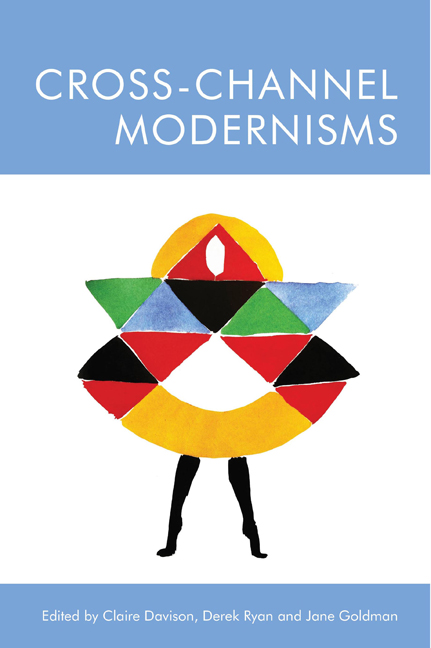Book contents
- Frontmatter
- Contents
- List of Figures
- Notes on Contributors
- Introduction: Cross-Channel (Transmanche) Modernisms
- Interlude: Translating
- 1 On Unknowing French? Rhythm and Le Rythme on a Cross-Channel Exchange
- 2 Impressions of Translation: Ford Madox Ford’s Cosmopolitan Literary Crossings
- 3 Sydney Schiff and Marcel Proust: Table-talk, Tribute, Translation
- Interlude: Fashioning
- 4 Cross-Channel Modernisms and the Vicissitudes of a Laughing Torso: Nina Hamnett, Artist, Bohemian and Writer in London and Paris
- 5 Jean Rhys’s comédie anglaise
- 6 Betray to Become: Departure in James Joyce’s A Portrait of the Artist as a Young Man
- Interlude: Mediating
- 7 Close Up and Cross-Channel Cinema Culture
- 8 Debussy at the Omega Workshops
- 9 Across the Other Channel: Elizabeth Bowen and Modernist Mediation
- Coda: ‘You, who cross the Channel’: Virginia Woolf, Departures and the Spectro-Aesthetics of Modernism 215
- Index
4 - Cross-Channel Modernisms and the Vicissitudes of a Laughing Torso: Nina Hamnett, Artist, Bohemian and Writer in London and Paris
Published online by Cambridge University Press: 03 October 2020
- Frontmatter
- Contents
- List of Figures
- Notes on Contributors
- Introduction: Cross-Channel (Transmanche) Modernisms
- Interlude: Translating
- 1 On Unknowing French? Rhythm and Le Rythme on a Cross-Channel Exchange
- 2 Impressions of Translation: Ford Madox Ford’s Cosmopolitan Literary Crossings
- 3 Sydney Schiff and Marcel Proust: Table-talk, Tribute, Translation
- Interlude: Fashioning
- 4 Cross-Channel Modernisms and the Vicissitudes of a Laughing Torso: Nina Hamnett, Artist, Bohemian and Writer in London and Paris
- 5 Jean Rhys’s comédie anglaise
- 6 Betray to Become: Departure in James Joyce’s A Portrait of the Artist as a Young Man
- Interlude: Mediating
- 7 Close Up and Cross-Channel Cinema Culture
- 8 Debussy at the Omega Workshops
- 9 Across the Other Channel: Elizabeth Bowen and Modernist Mediation
- Coda: ‘You, who cross the Channel’: Virginia Woolf, Departures and the Spectro-Aesthetics of Modernism 215
- Index
Summary
This chapter is the fruit of my own cross-Channel scholarly activities, beginning with a lecture in June 2010 to the conference titled ‘“No Hawkers: No Models”: The Vicissitudes of the Modernist Muse’, held at the University of Westminster, London. I developed this work in April 2015 for presentation to the ‘Cross-Channel Modernisms Symposium’ at Reid Hall in Paris (the University of Kent's Paris Campus). The latter version was in fact delivered twice within the space of a few days, first on the University of Kent's home campus and then in Paris. Shuttling between England and France via the Channel tunnel, I was already reworking my text on a remarkable modernist cross-Channel figure who had shuttled a little less speedily but with greater sartorial panache by boat-train a century earlier.
Laughing Torso (1932), the ‘reminiscences’ of Nina Hamnett (1890–1956), recounts her notorious cross-Channel vicissitudes as a struggling artist in the 1910s and 1920s in bohemian London and Paris. It opens up all kinds of interdisciplinary modernist crossings and channels. Hamnett's was an astonishing career not only as a visual artist (whose reputation has only recently been recovered) and as a muse, model and self-fashioning bohemian (whose excesses in the bars of Fitzrovia, Soho and Montparnasse, for many of her critics, eclipsed her other talents), but also as a writer. Reappraisal of Hamnett opens fascinating conduits to numerous modernist circles and to many pressing as well as entrenched critical and theoretical questions on modernism, including its international, transnational and geopolitical, trans-temporal and interdisciplinary, and its (trans-)performative, lived and embodied, and cross-gender framings. Hamnett, in her cross-Channel person as well as in her art and writing, may be productively considered in response to Virginia Woolf's question ‘who shall measure the heat and violence of the poet's heart when caught and tangled in a woman's body?’ (Woolf 1929: 73) .
Critics tend to focus either on Hamnett's early identification with the acclaimed modernist marble Torso (1914), the sculpture made by the French artist Henri Gaudier-Brzeska in response to a segment of her supple body as a fragment of classical statuary, or on her reputation as ‘Queen of Bohemia’ in both Soho and Montparnasse over many decades in the company of luminary modernist artists, writers and critics.
- Type
- Chapter
- Information
- Cross-Channel Modernisms , pp. 96 - 119Publisher: Edinburgh University PressPrint publication year: 2020



